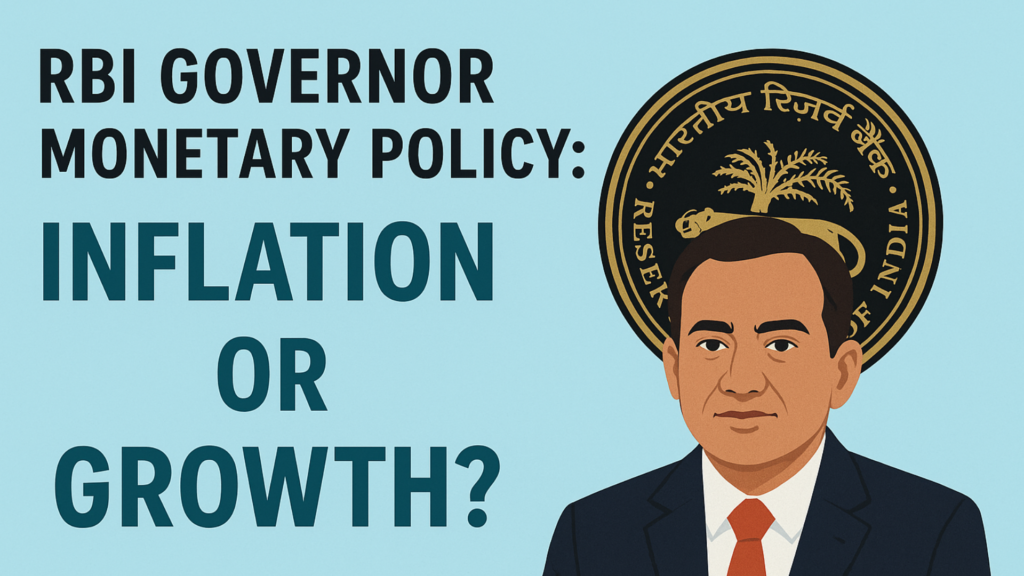

What is RBI Governor Monetary Policy? Its Inflation or Growth?
RBI Governor Emphasizes Balanced Approach Between Inflation and Growth for Future Rate Cuts
In a recent interview with CNBC TV18, Reserve Bank of India (RBI) Governor Sanjay Malhotra emphasized that both inflation and economic growth will play equally critical roles in determining the future course of interest rate decisions. With the central bank adopting a “neutral” policy stance, Malhotra highlighted that upcoming rate cuts or hikes will be driven by the evolving macroeconomic data, rather than short-term fluctuations.
Also Read; India’s Forex Reserves Cross $700 Billion Again: A Strong
Balancing Price Stability and Economic Growth
The core mandate of the RBI, as reiterated by Governor Malhotra, is to maintain price stability while supporting overall economic growth. This dual objective is particularly crucial in an environment marked by fluctuating inflation and moderate economic expansion. The governor clarified that the central bank does not prioritize inflation over growth or vice versa; instead, both are considered with equal weight in policy deliberations.
“Both inflation and growth are equally important,” said Malhotra. “The composition of inflation — including base effects and food prices — also has a significant influence on how we approach monetary policy.”
Repo Rate Trends and Economic Impact
In a series of policy moves earlier this year, the RBI lowered the benchmark repo rate by 25 basis points each in February and April, followed by a 50-basis point cut in June. This cumulative 100-basis point reduction in the repo rate, which determines the borrowing cost for banks, signals the central bank’s responsiveness to macroeconomic indicators. Economists at Nomura anticipate further 25-bps rate cuts in both October and December, potentially bringing the terminal rate down to 5%.
Lower interest rates are designed to stimulate economic activity by making credit more affordable for consumers and businesses. However, such decisions are contingent upon inflation remaining within manageable levels and growth not accelerating beyond expectations.
Also Read; Why Tesla Enters India? All New Showroom In Mumbai
Inflation Trends and Projections
Recent data supports the case for easing rates. Retail inflation, as measured by the Consumer Price Index (CPI), stood at just 2.1% in June — the lowest level since January 2019 — down from 2.82% in May and 3.16% in April. According to the RBI’s monetary policy outlook released in June, CPI inflation is projected to average around 3.7% in FY26, well within the central bank’s comfort zone.
These figures reflect a disinflationary trend, potentially creating room for further monetary easing if economic growth does not pick up pace.
Slowing Growth Raises Policy Dilemmas
On the growth front, India’s gross domestic product (GDP) expanded by 6.5% in FY25, the slowest in four years. While the RBI retained its forecast of 6.5% for FY26, the subdued performance raises questions about whether more monetary support is needed. During the monetary policy announcement in June, Malhotra acknowledged the growth rate was “lower than aspirations” but reaffirmed that any decision to adjust policy rates would be based on future data, not past performance.
“If growth weakens further, there is definitely a case for rate reduction,” Malhotra stated. “Conversely, if inflation begins to rise due to external or domestic shocks, we may have to consider tightening. It will all depend on the evolving data.”
Policy Stance: From Accommodative to Neutral
In a notable shift during the June monetary policy review, the RBI moved from an “accommodative” to a “neutral” policy stance. This means the RBI is no longer committed to keeping interest rates low and will instead base future decisions on real-time data. The sudden change came as a surprise, especially because the central bank had only recently adopted an accommodative stance two months prior.
Malhotra explained that with a 100-bps rate cut already implemented in recent months, the monetary policy had limited room to further support growth. However, a neutral stance provides the flexibility to respond dynamically to either inflationary pressures or slowing economic momentum.
Also Read; शून्य निवेश; बिजनेस आइडिया और निष्पादन रणनीति रणनीति
Outlook: Data-Driven Decisions to Prevail
Looking ahead, the RBI’s monetary policy will remain highly data-dependent. The central bank will assess a range of factors including inflation trends, core inflation components, global economic conditions, and domestic growth indicators before taking a call on further rate cuts or hikes.
Governor Malhotra’s comments underline a shift toward a more balanced and responsive monetary strategy, signaling that stakeholders — from financial markets to consumers — should prepare for nuanced, data-driven decisions rather than predictable policy paths.



